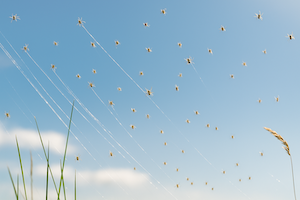Riding the Invisible Sky — a Glimpse of Wonder entry™ —
Picture a spider no bigger than a freckle, climbing to the tip of a blade of grass. It pauses, raises its front legs, and releases a thread of silk. The strand doesn’t just float on the breeze. It shivers, stretches, and suddenly carries the spider into the air. The tiny passenger is gone — not just drifting on wind, but sailing on something deeper.
Many who ride the air this way are spiderlings — baby spiders that hatch from a silken egg sac already looking like miniature adults. Dozens, sometimes hundreds, spill out at once. If they all stayed together, they would quickly starve or crowd each other out. So they climb upward, release silk, and let the sky carry them away. It’s not a seasonal migration like birds, but a one-way dispersal — a way to scatter, survive, and settle new ground.
 For years, people thought this “ballooning” was only about catching a gust. But researchers at the University of Bristol discovered it’s more than that. The earth’s electric field — that ever-present charge between sky and soil — tugs at the silk. The threads respond like invisible sails, drawing the spider upward on currents we can’t see. In this way, creatures without wings can cross rivers, mountains, and even oceans.
For years, people thought this “ballooning” was only about catching a gust. But researchers at the University of Bristol discovered it’s more than that. The earth’s electric field — that ever-present charge between sky and soil — tugs at the silk. The threads respond like invisible sails, drawing the spider upward on currents we can’t see. In this way, creatures without wings can cross rivers, mountains, and even oceans.
Isn’t it striking? A spider designed without wings, yet never grounded. Given a way to spread across continents, not in spite of its design, but because of it.
And if Jehovah gave even the smallest of his creatures such an ingenious way to travel, what about us? Isaiah 40:10 (NWT) declares: “Look! The Sovereign Lord Jehovah will come with power, and his arm will rule for him.” If the unseen pull of electricity can lift a spiderling skyward, how much more can Jehovah’s mighty arm carry us, steady us, and bring us exactly where we need to be?
References:
Morley, E.L. & Robert, D. (2018). Electric Fields Elicit Ballooning in Spiders. Current Biology. University of Bristol.
Missouri Department of Conservation. Ballooning Spiders.
The Guardian. (June 15, 2021). They look like waves: massive spider webs blanket Gippsland after Victorian floods.
Encyclopedia of Life. Entry on Erigone atra.
Encyclopedia of Life. Entry on Stegodyphus.
Wikipedia. Linyphiidae.
- dreamy, Matthew Gray, Roxessence and 1 other
-
 1
1
-
 2
2
-
 1
1

2 Comments
Recommended Comments
Join the conversation with your brothers and sisters!
You are posting as a guest. If you are already a member, sign in now to post with your existing account.
Note: Your post will require moderator approval before it will be visible.